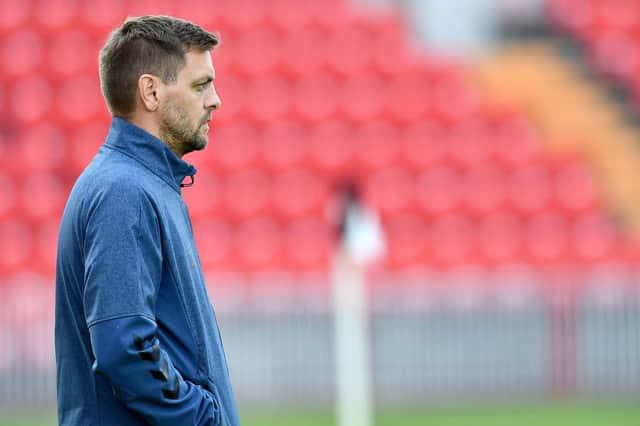Where it went wrong for Jonathan Woodgate at Middlesbrough and why it makes sense appointing ex-Sheffield United and Leeds boss Neil Warnock


After 18 months of functional and pragmatic football under Tony Pulis, Woodgate set out his plan to play an ‘attacking, exciting’ style while promoting players from the club’s highly-rated academy. It seems like everyone underestimated that challenge.
The thought of prompting a local, young head coach who could grow with the club, learn on the job and eventually help Boro push for promotion was certainly an appealing one. Perhaps it was always something of a fantasy though.
Advertisement
Hide AdAdvertisement
Hide AdTo be fair, not many, media and fans included, really imagined Boro would be in such a perilous position at this stage. The Teessiders had a decent squad on paper after finishing just a point outside the play-offs. Few expected promotion, yet surely the side was good enough to stay up.
Yet here we are, eight games to go with the club languishing above the bottom three on goal difference following Saturday’s woeful 3-0 defeat by Swansea City.
The fact that Boro had weeks to prepare for that game and have only now decided to replace Woodgate with the far more experienced Neil Warnock shows just how desperate the situation is.
Forget the ‘golden thread’ and new philosophy which was spoken about 12 months ago, relegation to League One in this climate would simply be a disaster. Gibson clearly isn’t prepared to take any chances.
Advertisement
Hide AdAdvertisement
Hide AdWarnock's appointment with immediate effect highlights that survival is all that counts right now. The 71-year-old has a track record for making his teams organised and difficult to beat. That certainly wasn’t the case against Swansea on Saturday.
The blame can’t solely be aimed at Woodgate, though, who was clearly desperate to prove himself and genuinely wanted to do well for the club.
As an aspiring, young coach, he was never going to turn down the chance to manage his boyhood team. It was a dream job for him.
Woodgate was let down by others in certain areas, most notably the club’s recruitment team after Boro brought in just three outfield players in the summer - none of which were immediately up to Championship standard.
Advertisement
Hide AdAdvertisement
Hide AdSome may argue that Woodgate had a similar squad to the one which Pulis left behind, yet the likes of Stewart Downing, Aden Flint, Mo Besic, John Obi Mikel and Jordan Hugill all represented experienced professionals who weren’t replaced.
Last season Pulis repeatedly spoke about how the squad lacked pace and power in wide areas - suggesting that was the reason behind Boro’s mundane approach.
Woodgate initially wanted his side to play in a 4-3-3 formation, yet aside from Marvin Johnson, who had just returned from a loan spell at Sheffield United, Boro didn’t appear to have any natural wingers.
After a woeful 4-1 defeat by Sheffield Wednesday and October’s shocking performance at Birmingham, Woodgate knew he had to do something. A change of formation to a back three with wing-backs at least brought more defensive security.
Advertisement
Hide AdAdvertisement
Hide AdSlowly but surely, Boro showed signs of improvement, it may not have been the swash-buckling football that Woodgate had spoken about but the Teessiders were keeping afloat.
By the end of last year there was a genuine sign that Boro’s vision was starting to take shape. December’s 2-0 win at league leaders West Brom was an excellent display, as was the win at Preston by the same scoreline on New Year’s Day.
The promotion of youth was also evident. Hayden Coulson, Djed Spence, Marcus Tavernier and Aynsley Pears had all become first-team regulars. It looked like Boro were turning a corner.
Patrick Roberts’ arrival on loan from Manchester City also raised expectations in a more productive January transfer window, and the pacey playmaker impressed as Woodgate’s Boro held Jose Mourinho’s Tottenham in a third-round FA Cup clash.
Advertisement
Hide AdAdvertisement
Hide AdYet the narrative in football can quickly change, as Woodgate has ultimately discovered.
When Boro conceded a last-minute equaliser at home to Derby on January 11, no one thought it would be the start of a fatal 10-match winless run in the league.
Yes there was a degree of misfortune after Boro lost key defender Daniel Ayala to a long-term ankle injury, as well as the lively Roberts to a lengthy hamstring issue.
Yet Boro should still have been able to stop the rot and prevent the season from spiralling to this point. The fact that Woodgate wasn’t capable of that became more and more alarming, especially after two shocking performances against relegation rivals Luton and Barnsley.
Advertisement
Hide AdAdvertisement
Hide AdDuring that treacherous run, the Boro head coach made changes, alternating between a back four and a back three as well as different variations up front.
The main criticism you can throw at Woodgate is it’s still unclear what his strongest side or system was.
That was highlighted again on Saturday after Boro started with a 4-2-3-1 set-up before a complete change at half-time.
Woodgate has been praised by his players this campaign and the mood has always seemed positive when visiting Boro’s Rockliffe training base this season.
Advertisement
Hide AdAdvertisement
Hide AdYet the squad needs clarity and a clear direction for a crucial run of eight Championship games, fixtures which will ultimately decide Boro’s division status.
The Woodgate project may have seemed plausible to Gibson this time last year, yet the risk of relegation was simply too great.
Warnock may not fit the managerial specification which Boro’s hierarchy drew up 12 months ago, yet the former Sheffield United, Leeds and Cardiff boss represents the best chance of beating the drop.